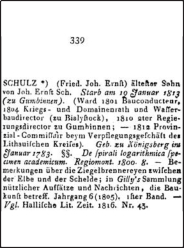- SCHULZ F J E
- GERMANY (see also List of Individuals)\
 .1.1783 Kaliningrad/RU - 19.1.1813 Gumbinnen/RU\Friedrich Johann Ernst Schulz was born and died in today's Russia, then a part of Eastern Prussia. He was from 1801 a Bauconductor, a kind of a building expert and he was appointed in 1804 director of hydraulic works of Bialystock, in today's Poland. In 1812 Schulz was elected vice director of the city of Gumbinnen; later he was a provincial commissioner of the Russian province Lithuania. The reason for his death at an age of only 30 years is unknown.\Schulz is known for his 1808 book on Contributions to the hydraulic architecture. The book includes chapters on harbor construction, on river navigation and on sluice gates, and represents a unique contribution to hydraulic engineering around 1800. It contains 24 large plates with a total of 232 figures illustrating the text with knowledge that Schulz gained during his short career. The careers of Schulz and Franz Funk (1768-1820) are similar: Both were practising engineers, they were mainly involved in river engineering works, and both published notable books that had some influence at the time, mainly on Gotthilf Hagen (1797-1884), then the nestor of German developments in the hydraulics and the works relating to river flow. Neither Funk's nor Schulz's contributions were definite, but their observations marked a trend that had some impact on later works and on later procedures for the improvement of rivers in the large plains of Northern Germany. Time was by then just not ripe for a physical background in hydraulics, despite the advances of Euler in the 18th century, or later those of for instance Henri Navier (1785-1836). These were hardly considered by the engineers who designed hydraulic structures. The 19th century was indeed an era where the theory and practice separated, and only the successes of typically Ludwig Prandtl (1875-1953) demonstrated to practicioners that the hydraulic problems are governed by physical laws that have to be accounted for. It should also be noted that the first hydraulic laboratories were erected around 1900, and added a third dimension to the then available methods of computation and nature.\Meusel, J.G. (1825). Schulz, Friedrich Johann Ernst. Das gelehrte Teutschland im 19. Jahrhundert 8: 339. Meyer: Lemgo.Poggendorff, J.C. (1863). Schulz, Friedrich Johann Ernst. Biographisch-Literarisches Handwörterbuch 2: 861-862. Barth: Leipzig, with bibliography.Schulz, F.J.E. (1805). Die Baukunst. Gilly's Sammlung nützlicher Aufsätze und Nachrichten 6. Schulz, F.J.E. (1808). Versuch einiger Beiträge zur hydraulischen Architektur. Nicolovius: Königsberg.
.1.1783 Kaliningrad/RU - 19.1.1813 Gumbinnen/RU\Friedrich Johann Ernst Schulz was born and died in today's Russia, then a part of Eastern Prussia. He was from 1801 a Bauconductor, a kind of a building expert and he was appointed in 1804 director of hydraulic works of Bialystock, in today's Poland. In 1812 Schulz was elected vice director of the city of Gumbinnen; later he was a provincial commissioner of the Russian province Lithuania. The reason for his death at an age of only 30 years is unknown.\Schulz is known for his 1808 book on Contributions to the hydraulic architecture. The book includes chapters on harbor construction, on river navigation and on sluice gates, and represents a unique contribution to hydraulic engineering around 1800. It contains 24 large plates with a total of 232 figures illustrating the text with knowledge that Schulz gained during his short career. The careers of Schulz and Franz Funk (1768-1820) are similar: Both were practising engineers, they were mainly involved in river engineering works, and both published notable books that had some influence at the time, mainly on Gotthilf Hagen (1797-1884), then the nestor of German developments in the hydraulics and the works relating to river flow. Neither Funk's nor Schulz's contributions were definite, but their observations marked a trend that had some impact on later works and on later procedures for the improvement of rivers in the large plains of Northern Germany. Time was by then just not ripe for a physical background in hydraulics, despite the advances of Euler in the 18th century, or later those of for instance Henri Navier (1785-1836). These were hardly considered by the engineers who designed hydraulic structures. The 19th century was indeed an era where the theory and practice separated, and only the successes of typically Ludwig Prandtl (1875-1953) demonstrated to practicioners that the hydraulic problems are governed by physical laws that have to be accounted for. It should also be noted that the first hydraulic laboratories were erected around 1900, and added a third dimension to the then available methods of computation and nature.\Meusel, J.G. (1825). Schulz, Friedrich Johann Ernst. Das gelehrte Teutschland im 19. Jahrhundert 8: 339. Meyer: Lemgo.Poggendorff, J.C. (1863). Schulz, Friedrich Johann Ernst. Biographisch-Literarisches Handwörterbuch 2: 861-862. Barth: Leipzig, with bibliography.Schulz, F.J.E. (1805). Die Baukunst. Gilly's Sammlung nützlicher Aufsätze und Nachrichten 6. Schulz, F.J.E. (1808). Versuch einiger Beiträge zur hydraulischen Architektur. Nicolovius: Königsberg.
Hydraulicians in Europe 1800-2000 . 2013.
